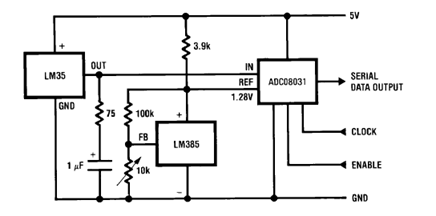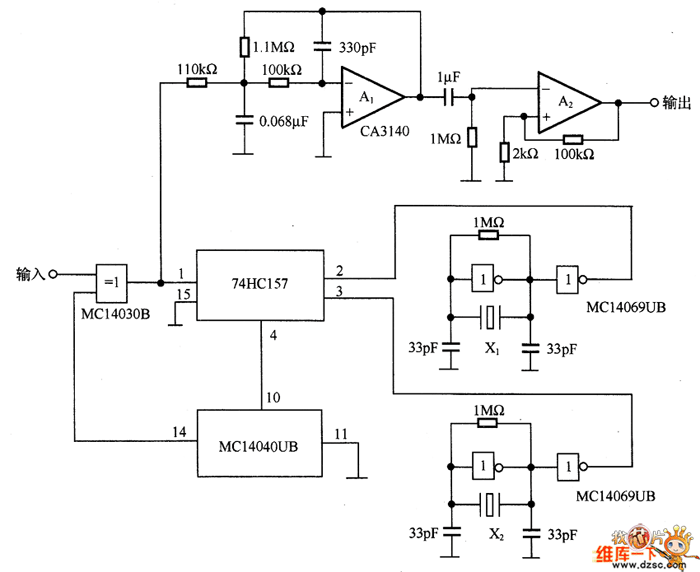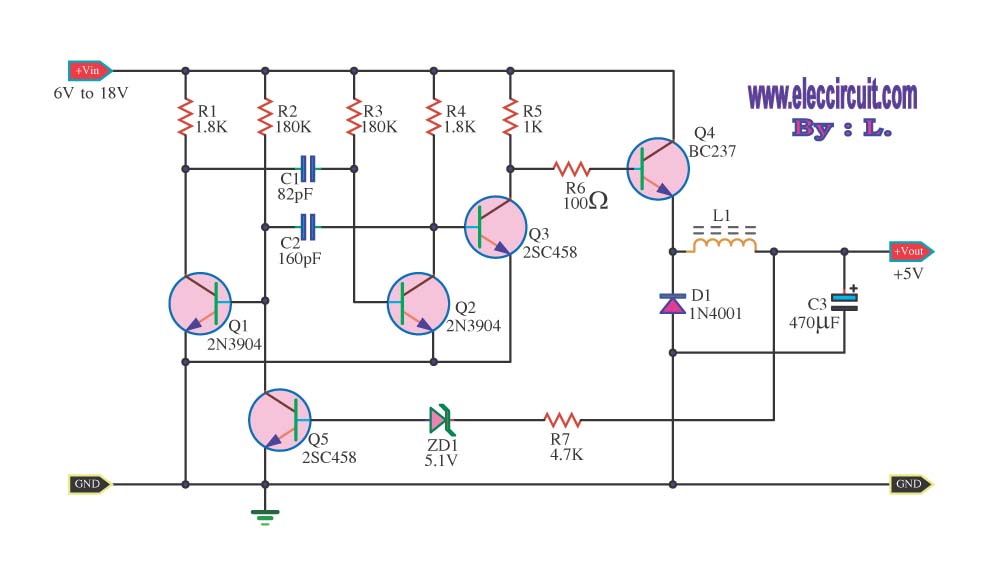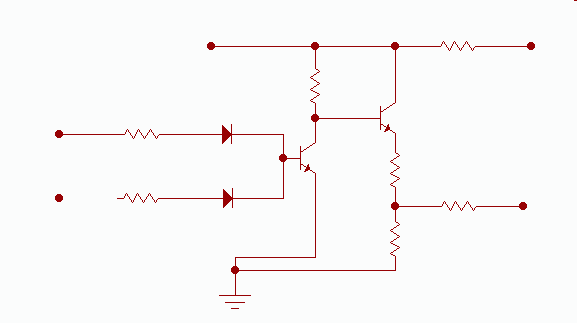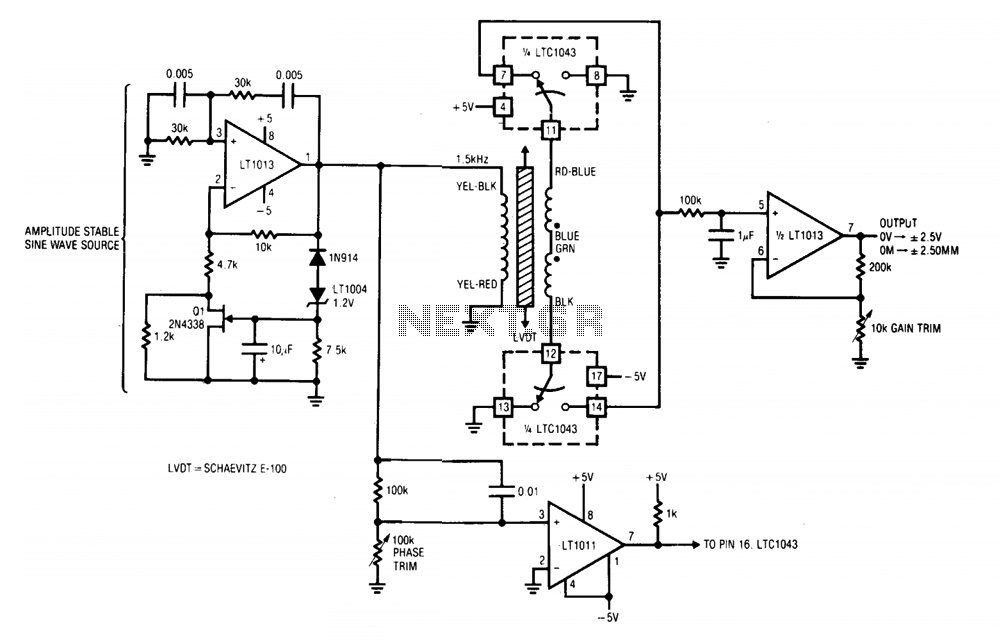
Audio/Video to UHF TV Signal Converter (Modulator)
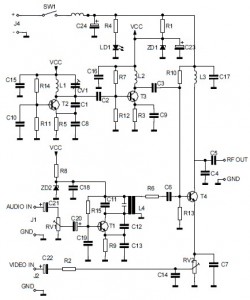
This is the circuit diagram of an audio/video modulator. The circuit converts audio and video signals into a UHF TV signal, allowing a video signal from a camera or other source to be connected to a standard TV set. The audio and video signals are transformed into a UHF TV signal for reception through a TV antenna. The circuit kit for this audio/video modulator is available for purchase at electronickits.com, which offers a complete kit including the PCB board and components. The schematic diagram of a video amplifier circuit is based on a high-speed operational amplifier IC, LH0032. Parts List: R1 = 15K, R2-3-4 = 10K, R5-R9 = 1K, R10 = 820, R11 = 1M, R12 = 100 trimmer, R13-R15 = 47, R14 = 10K, C1 = 10uF 63V MKT, C2-C4 = 100nF/63V, C3 = 4.7pF. The following diagram illustrates a 4-transistor FM transmitter circuit designed by Paul K. Sherby. Components List: R1, R2, R8 = 1K, R3 = 100K, R4 = 150K, R5, R7 = 10K, R6 = 220 ohm, R9 = 10 ohm, P1 = 5K trimpot, D1 = 1N4002, Q1, Q2 = 2N3904, Q3, Q4 = 7001, NTE123AP, C1. This is the circuit diagram of a mini FM receiver based on a single FM IC, TDA7012T. Component Parts List: R1 = 8K, R2 = 10K, R3 = 390, C1, C3 = 10nF, C2, C6, C9, C16 = 100nF, C4 = 33pF, C5 = 25pF trimmer (Murata type TZB4Z250AB10R00), C7, C10 = 1nF5, C8 = 820pF, C11 = 1nF, C12. The following diagram depicts small surround sound decoder schematics that can be used in home audio systems. Parts List: R1-2-7-8-12-13-18-19-20 = 47Kohm, R3-4-5-6-21-22-34-35 = 10Kohm, R9-10-11-14-15-16-17 = 15Kohm, R23-24-25-33-36 = 100ohm, R26-27-28-31-32 = 100Kohm, R29-30 = 5.6Kohm, C1-8 = 47uF 25V, C2-7-9-14-23 = 47nF 100V, C3-6 = 1uF 100V, C4-5-10 = 33pF 100V, C11-12-15 = 10uF 25V, C13 = 82nF, C16 = 18pF 100V, C17 = 100pF mini adjustable capacitor, C18 = 2.2nF, C19 = 4.7uF 25V, C20 = 100nF 100V, C21 = 10nF, C22 = 180pF. This circuit offers good quality FM transmission for stereo or other amplifiers, achieving a signal strength up to 500 meters with a power output of about 200 mW. It can be powered with a 9V battery. The audio-frequency modulation stage is constructed around the transistor BF494 (T1). This circuit represents a powerful three-stage, 9V FM transmitter (Tx) capable of transmitting over a distance of up to 1 kilometer in open conditions, utilizing an RF transistor in its output stage and two BC547 transistors for the first two stages. The transmission distance is critically dependent on operating conditions, whether within a building or outdoors.
The audio/video modulator circuit serves as a crucial link between various video sources, such as cameras and TV sets, by converting the input signals into a compatible format for UHF transmission. This allows for seamless integration of video content into standard television systems, enhancing viewing experiences. The circuit is designed to ensure high fidelity in both audio and video output, utilizing components that are readily available and easy to assemble.
The video amplifier circuit, based on the LH0032 operational amplifier, is engineered for high-speed processing of video signals. The choice of resistors and capacitors is critical for maintaining signal integrity and minimizing distortion. Each component value is selected to optimize the performance of the amplifier, ensuring that the output signal retains the quality of the original input.
The FM transmitter circuit designed by Paul K. Sherby employs a simple yet effective configuration using four transistors, which allows for efficient modulation of audio signals. The specified resistor values help set the gain and frequency response of the transmitter, while the use of a trimpot enables fine-tuning of the output level. The inclusion of diodes and transistors ensures reliable operation and signal amplification.
The mini FM receiver circuit, centered around the TDA7012T IC, showcases a compact design that is well-suited for portable applications. The component selection, including various capacitors and resistors, is tailored to maximize the receiver's sensitivity and selectivity, allowing for clear reception of FM broadcasts.
The surround sound decoder circuit is designed for integration into home audio systems, enhancing the listening experience by providing multi-channel audio output. The diverse range of resistor and capacitor values allows for precise tuning of the audio signals, ensuring balanced sound reproduction across different channels.
The high-quality FM transmitter circuit exemplifies the principles of RF design, providing a robust solution for audio transmission over significant distances. The use of a 9V battery for power supply ensures portability, making it suitable for various applications. The design emphasizes the importance of component selection and circuit layout in achieving optimal performance, particularly in terms of transmission range and audio clarity.This is the circuit diagram of audio/video modulator. The circuit will convert an audio and video signal into a UHF TV signal. It`s desired to connect a video signal originating from a camera or other video source to a normal TV set. The audio and video signal is converted into a UHF TV signal so that the signal can be received through the TV ante
nna input. The circuit kit of this audio/video modulator available to buy at electronickits. com. You may buy the complete kit of this circuit (PCB board and the components) there. This is schematic diagram of a video amplifier circuit, built based very high speed opamp IC LH0032. Parts List: R1 = 15K ©+15K © R2-3-4 = 10K © R5, R6, R7, R8, R9 = 1K © R10 = 820 © R11 = 1M © R12 = 100 © trimmer R13, R14, R15 = 47 © R14 = 10K © C1 = 10uF 63V MKT C2, C3, C4 = 100nF/63V C3 = 4. 7pF. The following diagram is the schematic diagram of 4 transistors FM transmitter circuit designed by Paul K.
Sherby. Components List: R1, R2, R8 = 1K R3 = 100K R4 = 150K R5, R7 = 10K R6 = 220 ohm R9 = 10 ohm P1 = 5K trimpot D1 = 1N4002 Q1, Q2 = 2N3904 Q3, Q4 = 7001, NTE123AP C1. This is the circuit diagram of mini FM received that build based on single FM IC TDA7012T. Component Parts List: R1 = 8k ©2 R2 = 10k © R3 = 390 © C1, C3 = 10nF C2, C6, C9, C16 = 100nF C4 = 33pF C5 = 25pF trimmer (Murata type TZB4Z250AB10R00) C7, C10 = 1nF5 C8 = 820pF C11 = 1nF C12.
The following diagram is an small surround sound decoder schematics. You may use this decoder surround sound systems for your home audio system. Parts List: R1-2-7-8-12-13-18-19-20=47Kohm R3-4-5-6-21-22-34-35=10Kohm R9-10-11-14-15-16-17=15Kohm R=23-24-25-33-36=100ohm R26-27-28-31-32=100Kohm R29-30=5. 6Kohm C1-8=47uF 25V C2-7-9-14-23=47nF 100V C3-6=1uF 100V C4-5-10=33pF 100V C11-12-15=10uF 25V C13=82nF C16=18pF 100V C17=100pF mini adjustable capacitor C18=2.
2nF C19=4. 7uF 25V C20=100nF 100V C21=10nF C22=180pF. This the Good Quality FM transmitter for your stereo or any other amplifier gives you a pretty good signal strength up to a range of 500 metres having a power output of about 200 mW. This circuit can be operated with a 9V battery. The audio-frequency modulation stage is constructed close to transistor BF494 (T1), . This circuit is a powerful three stage, 9V FM transmitter (Tx) with a range of up to 1 kilometer in the open.
It uses an RF transistor in its output stage and two BC547`s for the first two stages. Distance of trans-mission is critically dependent on the operating Conditions (in a building or out on. 🔗 External reference
The audio/video modulator circuit serves as a crucial link between various video sources, such as cameras and TV sets, by converting the input signals into a compatible format for UHF transmission. This allows for seamless integration of video content into standard television systems, enhancing viewing experiences. The circuit is designed to ensure high fidelity in both audio and video output, utilizing components that are readily available and easy to assemble.
The video amplifier circuit, based on the LH0032 operational amplifier, is engineered for high-speed processing of video signals. The choice of resistors and capacitors is critical for maintaining signal integrity and minimizing distortion. Each component value is selected to optimize the performance of the amplifier, ensuring that the output signal retains the quality of the original input.
The FM transmitter circuit designed by Paul K. Sherby employs a simple yet effective configuration using four transistors, which allows for efficient modulation of audio signals. The specified resistor values help set the gain and frequency response of the transmitter, while the use of a trimpot enables fine-tuning of the output level. The inclusion of diodes and transistors ensures reliable operation and signal amplification.
The mini FM receiver circuit, centered around the TDA7012T IC, showcases a compact design that is well-suited for portable applications. The component selection, including various capacitors and resistors, is tailored to maximize the receiver's sensitivity and selectivity, allowing for clear reception of FM broadcasts.
The surround sound decoder circuit is designed for integration into home audio systems, enhancing the listening experience by providing multi-channel audio output. The diverse range of resistor and capacitor values allows for precise tuning of the audio signals, ensuring balanced sound reproduction across different channels.
The high-quality FM transmitter circuit exemplifies the principles of RF design, providing a robust solution for audio transmission over significant distances. The use of a 9V battery for power supply ensures portability, making it suitable for various applications. The design emphasizes the importance of component selection and circuit layout in achieving optimal performance, particularly in terms of transmission range and audio clarity.This is the circuit diagram of audio/video modulator. The circuit will convert an audio and video signal into a UHF TV signal. It`s desired to connect a video signal originating from a camera or other video source to a normal TV set. The audio and video signal is converted into a UHF TV signal so that the signal can be received through the TV ante
nna input. The circuit kit of this audio/video modulator available to buy at electronickits. com. You may buy the complete kit of this circuit (PCB board and the components) there. This is schematic diagram of a video amplifier circuit, built based very high speed opamp IC LH0032. Parts List: R1 = 15K ©+15K © R2-3-4 = 10K © R5, R6, R7, R8, R9 = 1K © R10 = 820 © R11 = 1M © R12 = 100 © trimmer R13, R14, R15 = 47 © R14 = 10K © C1 = 10uF 63V MKT C2, C3, C4 = 100nF/63V C3 = 4. 7pF. The following diagram is the schematic diagram of 4 transistors FM transmitter circuit designed by Paul K.
Sherby. Components List: R1, R2, R8 = 1K R3 = 100K R4 = 150K R5, R7 = 10K R6 = 220 ohm R9 = 10 ohm P1 = 5K trimpot D1 = 1N4002 Q1, Q2 = 2N3904 Q3, Q4 = 7001, NTE123AP C1. This is the circuit diagram of mini FM received that build based on single FM IC TDA7012T. Component Parts List: R1 = 8k ©2 R2 = 10k © R3 = 390 © C1, C3 = 10nF C2, C6, C9, C16 = 100nF C4 = 33pF C5 = 25pF trimmer (Murata type TZB4Z250AB10R00) C7, C10 = 1nF5 C8 = 820pF C11 = 1nF C12.
The following diagram is an small surround sound decoder schematics. You may use this decoder surround sound systems for your home audio system. Parts List: R1-2-7-8-12-13-18-19-20=47Kohm R3-4-5-6-21-22-34-35=10Kohm R9-10-11-14-15-16-17=15Kohm R=23-24-25-33-36=100ohm R26-27-28-31-32=100Kohm R29-30=5. 6Kohm C1-8=47uF 25V C2-7-9-14-23=47nF 100V C3-6=1uF 100V C4-5-10=33pF 100V C11-12-15=10uF 25V C13=82nF C16=18pF 100V C17=100pF mini adjustable capacitor C18=2.
2nF C19=4. 7uF 25V C20=100nF 100V C21=10nF C22=180pF. This the Good Quality FM transmitter for your stereo or any other amplifier gives you a pretty good signal strength up to a range of 500 metres having a power output of about 200 mW. This circuit can be operated with a 9V battery. The audio-frequency modulation stage is constructed close to transistor BF494 (T1), . This circuit is a powerful three stage, 9V FM transmitter (Tx) with a range of up to 1 kilometer in the open.
It uses an RF transistor in its output stage and two BC547`s for the first two stages. Distance of trans-mission is critically dependent on the operating Conditions (in a building or out on. 🔗 External reference
